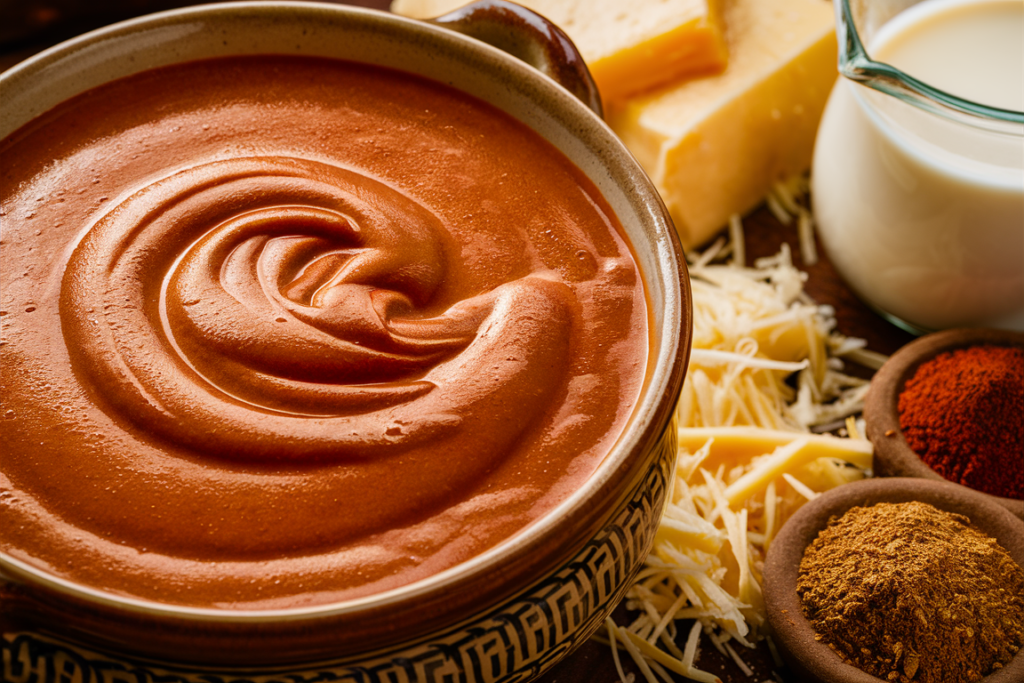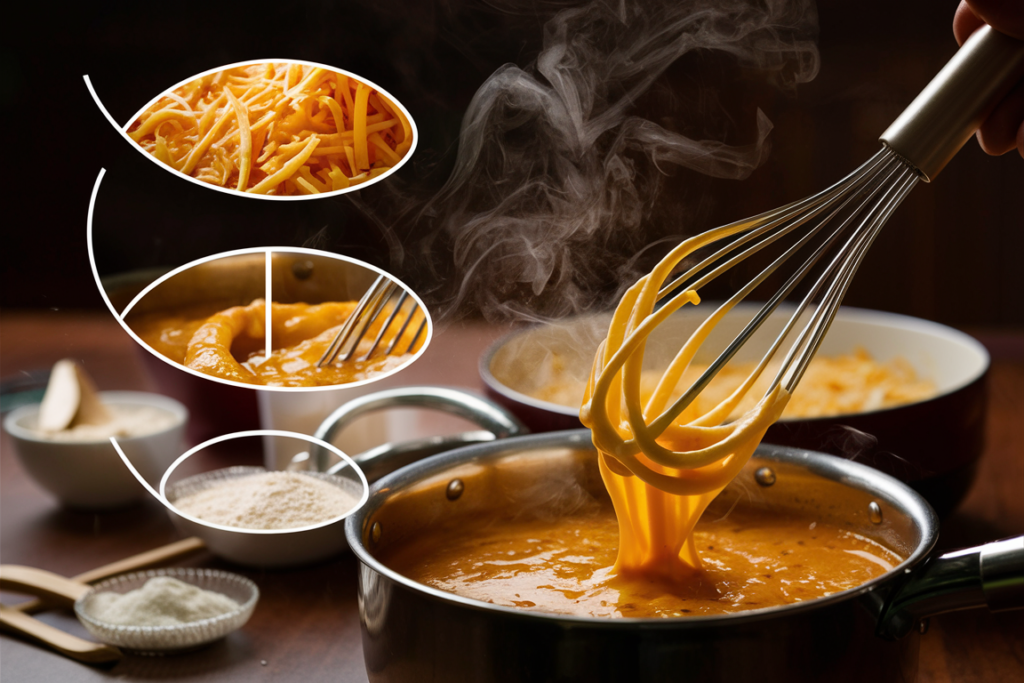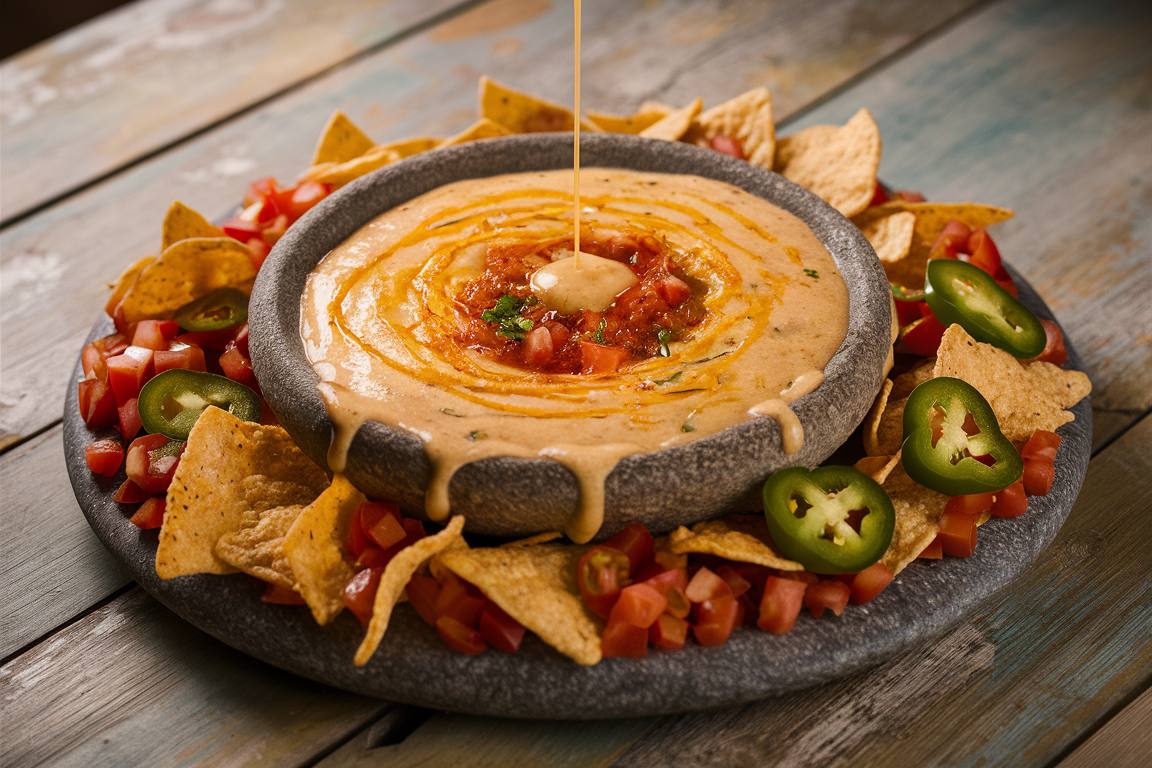Part 1: The Ultimate Guide to Creamy Queso
1. Introduction to Creamy Queso
Queso, the velvety, cheesy delight often found gracing nachos, tacos, and party tables, is an iconic dip that can make or break any gathering. While it seems simple, the art of keeping queso creamy is a kitchen challenge many face.

Why does creaminess matter?
- A smooth queso ensures even coating on chips.
- Creamy texture elevates its flavor profile, making it irresistible.
Common challenges with queso:
- Separation, where the oil pools and cheese clumps.
- Thickening or hardening when left to cool.
- A grainy texture caused by overheating or incorrect ingredient ratios.
Understanding what makes queso creamy and smooth is the first step toward perfection.
2. Understanding the Ingredients of Queso
The ingredients in queso play a crucial role in achieving its signature creamy texture. By selecting and combining them thoughtfully, you can avoid common issues like clumping or separation.
Key Components:
- Cheese: As the main ingredient, cheese provides the rich, velvety base of queso. Choosing the right type is essential for optimal texture and flavor.
- Liquid Base: Milk, cream, or broth adds the fluidity needed for queso’s pourable consistency. Each option brings a slightly different richness to the dish.
- Stabilizers: To prevent separation or clumping, stabilizers like cornstarch or sodium citrate act as binders, ensuring the cheese and liquid stay emulsified.
Ingredients to Approach with Caution:
- Aged Cheeses: While flavorful, their lower moisture content can lead to a gritty texture when melted.
- Acidic Additions: Ingredients like tomatoes, lime juice, or vinegar can cause the mixture to curdle unless properly balanced with stabilizers or other ingredients.
By understanding the role of each ingredient and blending them harmoniously, you can craft a queso that stays smooth and creamy from preparation to serving.
3. Ideal Cheese Choices for Creamy Queso
The type of cheese you use has a profound impact on queso’s texture.
Why high-moisture cheeses work best:
- They melt evenly and maintain a smooth texture.
- They’re less prone to separating when heated.
Cheese recommendations:
- Cheddar: A classic, providing rich flavor and smooth melting.
- Monterey Jack: Known for its creamy, mild flavor.
- Colby: Adds elasticity to queso.
- Blends: Combining different cheeses can enhance flavor and consistency.
Experiment with ratios, but remember: the right cheese mix is key to mastering smooth, creamy queso.
4. Importance of Temperature Control
Temperature is a critical factor in queso preparation.
What happens with heat:
- Overheating can cause the proteins in cheese to tighten, leading to separation.
- Insufficient heat may result in uneven melting or clumps.
How to manage temperature:
- Low and slow cooking: Melt cheese gradually over low heat to maintain its texture.
- Use a double boiler: Prevent direct heat contact for consistent temperature.
- Serve with warming trays: Keep queso warm without overheating.
A consistent temperature ensures your queso remains creamy for hours.
5. Techniques for Preventing Clumps in Queso
Clumps in queso are a common frustration, but there are ways to avoid this.
Key tips:
- Shred cheese finely: Finer pieces melt faster and more evenly.
- Use a roux: Mixing flour or cornstarch with butter creates a smooth base for the queso.
- Add cheese gradually: Incorporate small amounts at a time, stirring continuously.
- Avoid overheating: Excessive heat causes the cheese to seize.
By using these techniques, you’ll enjoy a perfectly smooth queso every time.
6. Choosing the Right Liquid Base
The choice of liquid base affects both the flavor and texture of your queso.
Liquid options:
- Milk: Adds creaminess without overpowering the cheese flavor.
- Cream: Creates a richer, more indulgent texture.
- Evaporated milk: Stabilizes queso for consistent smoothness.
Ideal ratios:
- Start with a 1:1 ratio of cheese to liquid, then adjust for desired thickness.
- Too much liquid can dilute the flavor, while too little may lead to clumping.
Finding the perfect balance is essential for creamy queso that pours effortlessly.
7. Adding Stabilizers for Creamy Queso
Stabilizers help queso maintain its texture and prevent dreaded separation.
Popular stabilizers:
- Cornstarch or flour: Adds thickness and keeps queso smooth.
- Sodium citrate: An emulsifying agent that binds cheese and liquid together.
- Cream cheese: Introduces creaminess while acting as a natural stabilizer.
By incorporating the right stabilizer, you can ensure your queso stays silky and cohesive.
8. How to Reheat Queso Without Losing Creaminess
Reheating queso can often lead to grainy or oily results if not done correctly.
Best reheating methods:
- Stovetop: Use low heat, stirring frequently to redistribute melted fats.
- Microwave: Heat in 15-second intervals, stirring between each session.
- Double boiler: Prevent direct heat for gentle reheating.
Adding a splash of milk or cream during reheating can restore the creamy consistency.
9. Preventing Skin or Film on Queso
The surface of queso can develop a skin when exposed to air.
How to prevent it:
- Cover queso: Use a lid or plastic wrap when not in use.
- Stir frequently: Regular stirring prevents a film from forming.
- Serve with warming equipment: Slow cookers or fondue pots help maintain a creamy surface.
Taking these steps ensures your queso remains appealing and smooth.
10. Best Equipment for Serving Queso
Serving equipment can make or break the queso experience.
Recommended tools:
- Slow cookers: Maintain consistent heat for extended periods.
- Fondue pots: Ideal for small gatherings, providing a cozy serving option.
- Heat-resistant bowls: Keep queso warm with less risk of burning.
Choosing the right equipment ensures your queso stays hot, creamy, and inviting throughout any event.
Part 2: Advanced Tips and Techniques for Creamy Queso
11. Common Mistakes to Avoid When Making Queso
Even though queso is a simple dish at its core, there are several pitfalls that can turn a smooth, creamy dip into a clumpy or greasy mess. Fortunately, these common mistakes are easy to avoid once you know what to look out for.

1. Overcooking Cheese
- When cheese is overheated, its proteins tighten and expel fat, leading to separation and a greasy texture.
- To prevent this, melt cheese over low heat, stirring consistently to avoid hot spots.
2. Skipping Stabilizers
- Many home cooks overlook the importance of stabilizers like cornstarch or sodium citrate, which help keep queso smooth.
- Adding a small amount of stabilizer during preparation can ensure a cohesive texture.
3. Ignoring Ingredient Quality
- Pre-shredded cheese often contains anti-caking agents that inhibit smooth melting.
- Always use freshly shredded cheese for the best results.
By understanding these common errors and how to avoid them, you’ll set yourself up for success with a queso that’s consistently creamy and smooth.
12. Flavor Enhancements Without Compromising Texture
Enhancing queso with bold flavors can elevate it to a new level, but overloading it with ingredients can cause separation or clumping. With the right techniques, you can keep your queso creamy while infusing it with exciting flavors.
Adding Spices and Aromatics
- Incorporate ground cumin, chili powder, or smoked paprika for added depth.
- For a more aromatic flavor, sauté garlic and onions before adding them to your queso base.
Chunky Ingredients
- Stir in diced tomatoes, jalapeños, or roasted peppers to create a flavorful, textured dip.
- Avoid adding too much liquid from ingredients like canned tomatoes, as it can dilute the queso.
Including Proteins
- Cooked ground beef, chorizo, or shredded chicken can make your queso heartier.
- Be cautious not to add overly greasy proteins, as they may destabilize the cheese.
With these strategies, you can boost the flavor of your queso while ensuring it remains smooth and creamy.
13. Low-Fat or Dairy-Free Alternatives for Creamy Queso
For those with dietary restrictions or preferences, creating a creamy queso without traditional cheese or cream is entirely possible. However, achieving the right consistency with alternative ingredients requires careful substitutions and techniques.
Low-Fat Options
- Reduced-fat cheeses can work, but they often lack the richness of full-fat varieties. To compensate, add a dollop of cream cheese or a small amount of butter.
- Use cornstarch or arrowroot powder to thicken the queso and enhance its texture.
Dairy-Free Solutions
- Vegan cheeses made from cashews or almonds are excellent alternatives for dairy-free queso.
- Combine soaked cashews with almond milk, nutritional yeast, and seasonings to create a creamy, cheese-like base.
Tips for Success
- Add stabilizers, such as tapioca starch, to improve the consistency of plant-based or low-fat queso.
- For a cheesy flavor, use nutritional yeast in combination with dairy-free ingredients.
By using these substitutions, you can create a queso that suits your dietary needs while retaining its signature creaminess.
14. Maintaining Queso for Parties and Gatherings
Keeping queso creamy during long events or parties can be a challenge. It’s essential to manage both temperature and presentation to ensure your dip stays appealing throughout.
Tips for Longevity
- Use warming trays, fondue pots, or slow cookers to maintain a consistent serving temperature.
- Stir the queso frequently to prevent a skin from forming on the surface.
Insulated Dishes
- For smaller gatherings, preheat an insulated bowl with hot water, then transfer the queso to the dish. This can keep it warm for up to an hour without the need for external heat.
- Avoid overfilling the bowl, as thinner layers of queso retain heat better.
Refreshing the Texture
- During the event, if the queso thickens, stir in a small amount of warm milk or cream to restore its consistency.
- Keep a ladle or spoon handy for guests to stir the dip as they serve themselves.
With these simple techniques, you can serve queso that stays creamy and delicious from start to finish.
15. Enhancing Shelf Life and Storing Leftover Queso
If you have leftover queso, proper storage and reheating methods are essential to preserving its texture and flavor. While queso is best served fresh, these tips can help you make the most of your leftovers.
Storage Tips
- Refrigerate: Allow the queso to cool completely before transferring it to an airtight container. Store in the refrigerator for up to four days.
- Freeze: Although freezing may slightly alter the texture, you can freeze queso in small portions. Thaw in the refrigerator before reheating.
Reheating Leftover Queso
- Stovetop: Reheat the queso over low heat, stirring frequently. Add a splash of milk or cream to revive the texture.
- Microwave: Heat in short intervals of 15–20 seconds, stirring between each to avoid uneven heating.
By storing and reheating queso carefully, you can enjoy its creamy goodness even days after it was made.
16. DIY Recipes for Creamy Queso
Making queso from scratch allows you to control every aspect of its flavor and texture. Here are some easy-to-follow recipes to get you started:
Classic Queso
- Ingredients: Cheddar cheese, milk, butter, cornstarch, and spices like chili powder and cumin.
- Method: Begin with a roux (butter and cornstarch), add milk to form a base, and gradually stir in shredded cheese until melted.
Spicy Queso
- Add-ins: Mix in diced jalapeños, hot sauce, or cayenne pepper for an extra kick.
- Cheese Options: Blend cheddar with pepper jack for a spicier, more dynamic flavor.
Customizable Tips
- Experiment with cheese blends to find your favorite combination.
- Stir in ingredients like roasted tomatoes, chorizo, or fresh herbs for unique twists.
These recipes allow you to create a queso that’s as delicious and creamy as it is customizable.
17. Queso for Dietary Preferences: Gluten-Free, Vegan, and More
Adapting queso for specific dietary needs doesn’t mean compromising on texture or flavor. By using alternative ingredients thoughtfully, you can make queso suitable for everyone.
Gluten-Free Queso
- Replace flour with cornstarch or arrowroot as a thickener.
- Check the labels of store-bought cheese and other ingredients to ensure they’re gluten-free.
Vegan Queso
- Blend soaked cashews with almond milk, nutritional yeast, and spices for a creamy, cheese-like base.
- Use plant-based cheeses that are specifically designed to melt well.
Other Adjustments
- Low-sodium diets: Use unsalted cheese and season sparingly.
- Keto-friendly: Incorporate xanthan gum as a thickener instead of flour or cornstarch.
By making these adjustments, you can create a queso that suits a variety of dietary preferences while maintaining its signature creaminess.
18. Scientific Principles Behind Creamy Queso
Understanding the science of queso can help you troubleshoot texture issues and achieve consistently great results.
The Role of Emulsification
- Emulsification occurs when fats and proteins in cheese bond with liquid to create a smooth mixture. Adding stabilizers like sodium citrate helps this process.
Melting Points
- Cheeses with high moisture content, such as Monterey Jack or young cheddar, melt more easily and create a creamier texture. In contrast, aged cheeses may become gritty.
Protein and Fat Interactions
- Excess heat causes cheese proteins to contract and expel fat, leading to separation. Controlling temperature is essential for maintaining a cohesive texture.
By applying these scientific principles, you can make queso that is perfectly creamy and stable every time.
19. Popular Dishes to Serve with Queso
Queso is a versatile dip that pairs well with countless dishes. Incorporating it into your meals can elevate simple recipes into unforgettable favorites.
Classic Pairings
- Nachos: Drizzle queso over tortilla chips and top with jalapeños, salsa, and sour cream for a crowd-pleasing snack.
- Tacos: Use queso as a sauce for soft or hard-shell tacos to add an extra layer of flavor.
Creative Ideas
- Queso-Stuffed Peppers: Fill bell peppers with rice, beans, and queso for a delicious entrée.
- Burgers: Replace traditional cheese slices with a dollop of queso for a decadent twist.
Side Dishes
- Serve queso alongside soft pretzels, roasted vegetables, or even fries for a dipping option that’s hard to resist.
By exploring these serving ideas, you can discover just how versatile and delicious queso can be.
Part 3: Mastering the Art of Perfect Queso
21. Regional Variations of Queso
Queso is not the same everywhere; its preparation and flavors vary widely depending on regional influences. By exploring these variations, you can find the perfect style to match your taste preferences.

Tex-Mex Queso
- Often made with processed cheeses like Velveeta, this variation is known for its smooth texture and mild spice.
- Ingredients like canned tomatoes and green chilies (e.g., Rotel) add a classic Tex-Mex kick.
Mexican Queso Fundido
- Unlike Tex-Mex queso, this version is thicker and baked. It frequently features cheeses like Oaxaca or Chihuahua, which are prized for their exceptional melting properties.
- Sautéed chorizo or roasted poblano peppers are often added for bold flavor.
Southwest-Inspired Queso
- This version blends queso with hearty ingredients like roasted corn, black beans, and diced jalapeños.
- Pairing it with blue corn tortilla chips enhances the rustic Southwestern experience.
By trying different regional styles, you can discover how queso evolves across culinary traditions while maintaining its creamy charm.
22. Pairing Queso with Drinks
Queso isn’t just about the food—it’s also about creating the perfect dining experience. Choosing the right beverages can elevate your queso-serving occasions.
Best Drink Pairings:
- Beer: Light lagers and crisp IPAs are excellent choices because they cut through queso’s rich texture.
- Margaritas: A classic margarita with fresh lime juice provides a zesty counterbalance to the creamy queso.
- Sangria: Fruity sangria pairs well with spicier queso recipes, offering a refreshing contrast.
Non-Alcoholic Options:
- Iced Tea: Whether sweetened or unsweetened, iced tea works well to cleanse the palate.
- Sparkling Water: For those avoiding sugary drinks, sparkling water adds a refreshing fizz that enhances the meal.
When you carefully select drinks to pair with queso, the overall dining experience becomes more enjoyable and memorable.
23. How to Host a Queso-Themed Party
For gatherings where queso takes center stage, hosting a queso-themed party is a creative way to impress guests.
Planning the Menu
- Offer multiple variations of queso to cater to diverse tastes, such as classic, spicy, and dairy-free options.
- Include a variety of dippers like tortilla chips, pretzels, and sliced vegetables to keep the spread exciting.
Setting Up the Spread
- Use slow cookers or fondue pots to keep the queso warm throughout the event. This ensures guests can enjoy it at its best for hours.
- Provide topping options like diced tomatoes, fresh cilantro, and jalapeños, so guests can customize their servings.
Engaging Your Guests
- Set up a queso-tasting station with recipe cards, encouraging guests to vote for their favorite variation.
- Incorporate a “build-your-own nacho” bar to make the experience interactive.
With thoughtful planning and attention to detail, a queso-themed party can become a fun and interactive event that’s hard to forget.
24. Queso Hacks for Quick Prep
Not every queso-making session needs to take hours. By using these time-saving hacks, you can have a creamy dip ready in no time.
Microwave Shortcut
- Combine shredded cheese, milk, and a stabilizer like cornstarch in a microwave-safe bowl.
- Heat in 30-second intervals, stirring in between, until the mixture is smooth and creamy.
Using Store-Bought Cheese Sauces
- Enhance pre-made queso with fresh ingredients such as roasted peppers, diced onions, or a dash of hot sauce.
- Add cream cheese or sour cream to make store-bought options taste more homemade.
Frozen Options
- Keep homemade queso frozen in small, individual portions for quick reheating.
- Thaw it in the refrigerator overnight, and add milk while reheating to restore its creamy texture.
By applying these simple tricks, you can ensure that making queso becomes a fast and fuss-free process.
25. Exploring Non-Traditional Queso Dishes
Queso is more versatile than you might imagine. Moving beyond its role as a dip, it can also be used to create innovative dishes.
Breakfast Queso
- Drizzle queso over scrambled eggs or breakfast burritos to elevate your morning meal.
- Use it as a sauce for breakfast skillets with roasted potatoes, bacon, and onions.
Queso-Stuffed Appetizers
- Fill jalapeño poppers or mini bell peppers with queso for bite-sized party snacks.
- Add queso to empanadas or taquitos for a cheesy surprise.
Pasta and Casseroles
- Substitute queso for traditional béchamel sauce in macaroni and cheese.
- Use it as a creamy topping for baked casseroles, ensuring every bite is rich and cheesy.
These non-traditional dishes allow you to experiment with queso in exciting and unexpected ways.
26. Perfecting Queso for Outdoor Events
Serving queso outdoors can be tricky, especially when it comes to maintaining its creamy consistency. However, a few adjustments can ensure success.
Tips for Outdoor Events
- Use insulated serving dishes to keep queso warm without requiring electricity.
- Opt for thicker queso recipes that are less likely to harden as they cool.
Portable Heating Solutions
- Small propane stoves or portable burners are excellent for keeping queso warm.
- Solar-powered warming trays offer an eco-friendly option for maintaining temperature.
By anticipating outdoor challenges and planning accordingly, you can serve queso that stays creamy and delicious in any setting.
27. The Role of Queso in Cultural Celebrations
Queso is more than a dish—it’s a beloved centerpiece at many gatherings, enhancing the spirit of cultural celebrations.
Cinco de Mayo
- Frequently served alongside guacamole and salsa, queso plays a key role in celebrating Mexican heritage during this festive holiday.
Game Day
- No football watch party is complete without queso, which pairs perfectly with chips, beer, and other snacks.
Family Reunions
- Because queso is easy to prepare in large quantities, it’s a reliable favorite at reunions and potlucks.
Whether it’s part of a formal celebration or a casual get-together, queso enhances the festive atmosphere.
28. How Restaurants Keep Queso Creamy
If you’ve ever wondered how restaurants maintain perfectly creamy queso, the answer lies in their professional techniques.
Commercial Stabilizers
- Many restaurants use emulsifiers like sodium citrate to ensure their queso remains smooth and consistent.
Consistent Heating
- Professional-grade warming equipment, such as heated serving dishes or bain-marie systems, keeps queso at an ideal temperature.
Pre-Portioning
- Serving queso in small, manageable portions minimizes the risk of skin formation and keeps the texture smooth for each customer.
Adopting these techniques at home can help you achieve the same restaurant-quality queso experience.
29. The Future of Queso: Innovative Trends
As culinary trends evolve, queso is no exception. From health-conscious options to global flavors, queso continues to adapt.
Plant-Based Innovations
- Vegan quesos made from ingredients like cashews, nutritional yeast, and cauliflower are becoming increasingly popular.
- New plant-based cheese products are being designed to melt as well as traditional dairy cheese.
Global Influences
- Adding spices like curry or harissa introduces unique, international flavors to queso.
- Fusion dishes, such as queso-topped sushi rolls or queso birria tacos, are gaining traction.
Health-Conscious Options
- Probiotic cheeses and low-fat recipes cater to health-conscious diners while maintaining creamy textures.
- Keto-friendly adaptations use alternative thickeners, such as xanthan gum, instead of traditional starch.
As these trends gain momentum, queso remains a versatile and evolving dish that appeals to a wide range of preferences.
30. Final Thoughts on Keeping Queso Creamy
Ultimately, making and maintaining creamy queso is as much about technique as it is about ingredient quality. By carefully selecting your cheese, controlling heat, and using stabilizers, you can create queso that remains smooth, flavorful, and utterly irresistible for any occasion. Whether you’re hosting a party, experimenting with new recipes, or adapting it for dietary needs, queso will always be a crowd-pleaser.
More FAQs About Queso
- What is the best liquid for making queso?
- Whole milk or evaporated milk are ideal for achieving creaminess and stability.
- Can I use queso as a pasta sauce?
- Absolutely! It makes a rich and cheesy alternative to traditional pasta sauces.
- Why does my queso harden quickly?
- It cools rapidly; keeping it warm with slow cookers or insulated dishes helps maintain texture.
- Can I fix separated queso?
- Yes, reheat it slowly with milk or cream and whisk until smooth.
- What spices work best in queso?
- Cumin, chili powder, and smoked paprika add depth without overpowering the cheese.
- Can I add alcohol to queso?
- Beer or tequila are great options, but use them sparingly to avoid thinning the dip.
- How do I make queso gluten-free?
- Use cornstarch or arrowroot instead of flour for thickening.
- What’s the best way to serve queso at a picnic?
- Insulated thermoses or portable warming trays work well for outdoor events.
- How do I thin queso that’s too thick?
- Stir in small amounts of milk or broth until the desired consistency is reached.
- Can I make queso spicy without jalapeños?
- Use cayenne pepper, hot sauce, or chipotle powder for added heat.

